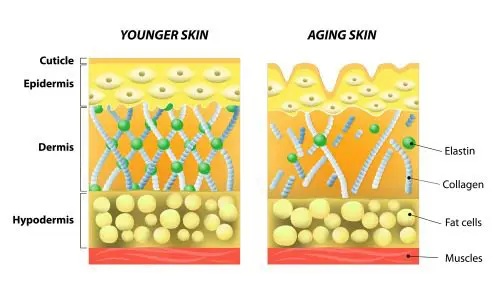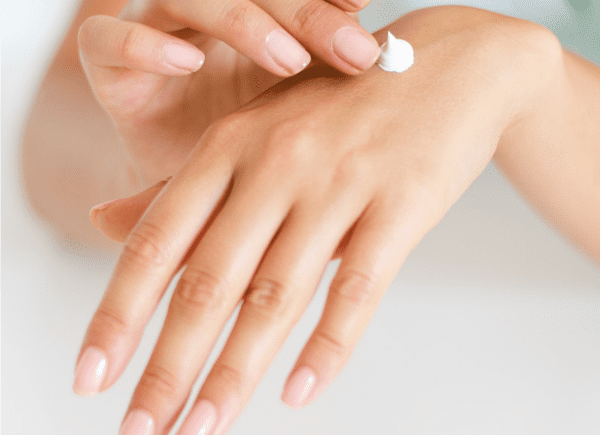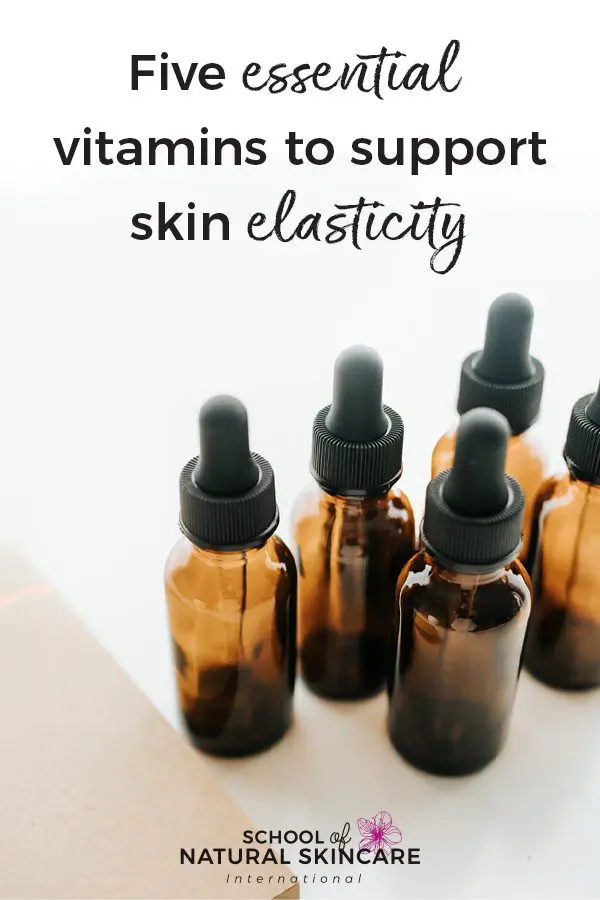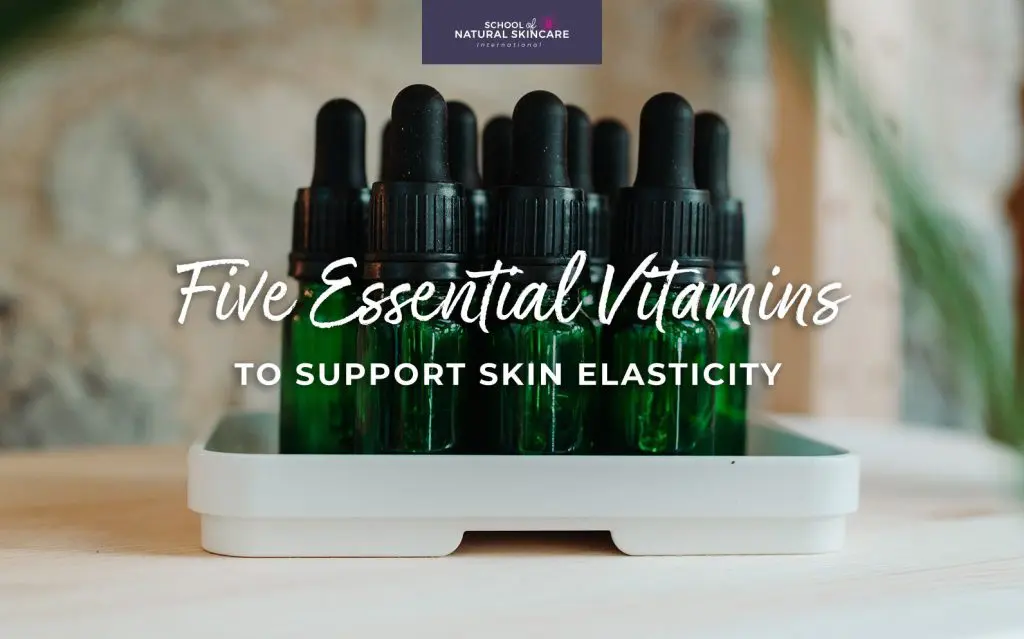The natural aging process reduces the elasticity of our skin. While this can be accepted as part of aging gracefully, there are vitamins that can help support and improve skin elasticity and therefore help improve the appearance of aging skin.
Let’s take a look at five useful vitamins and how they are used in skincare products to support skin elasticity and therefore reduce the signs of aging.
The vitamins we’ll focus on are:

The role of collagen and elastin in skin elasticity
The skin is made up of the epidermis; the outermost layer of the skin which holds in moisture and provides protection against harmful substances; and the dermis, which contains blood vessels, nerves, glands, and collagen and elastin, essential proteins for building and maintaining the skin’s structure.
Collagen is a group of essential proteins that are naturally produced by our bodies and are found mostly in the connective tissues of the body where they provide strength and firmness to tissues. Collagen is also well known for maintaining tight, flexible, firm and youthful-looking skin (1).
Elastin is also a protein found in the connective tissues but it is important to understand that it is a different type of protein to collagen. Where the presence of collagen ensures strength and rigidity to the connective tissues, the presence of elastin allows tissues in the body to return to their original shape after being stretched or contracted.
As the skin ages, the production of these proteins decline and, the collagen and elastin fibres that help support the skin structure tend to break, lose their elasticity, thicken, stiffen, and can even clump together.
The decline in production of these proteins can also be accelerated by environmental stressors such as overexposure to the sun, stress, smoking, dietary intake, etc.
Consequently, the skin starts to deteriorate in function and appearance and become characterized by the common signs of aging, ie wrinkles and fine lines, thinning of the skin, loss of elasticity, etc.

Vitamins are natural organic compounds that cannot be synthesized by the human body but are vital for the maintenance and health of the skin, which is our body’s largest organ. In adults, loss of skin elasticity is normally related to the inevitable aging process but can also be due to a deficiency in vitamins A, B, C, E and K.
In this article, we will review each of these five vitamins; what they are, their functions and how this relates to skin elasticity as well as the types of cosmetic products they can be found in.
Vitamin A
Firstly, let’s start with vitamin A. Vitamin A is a group of fat-soluble, unsaturated organic compounds, and its derivatives are known as retinoids or carotenoids. Retinoids are found in animal sources (eg fish, eggs, milk, cheese, etc.) and include retinol, retinyl acetate and retinyl palmitate, whereas carotenoids are found in plant-based foods (eg carrots). A well-known example of a carotenoid is beta-carotene.
Retinoic acid exists naturally inside the cells of our body, and is the active form that can readily be used by the cells to perform its cellular functions. However, when it comes to vitamin A derivatives these must undergo an enzymatic conversion process to be converted into retinoic acid before they can be used by to the cells in the skin. For example, when retinol is applied to the skin, the enzymes in the skin convert retinol into retinyl aldehyde and then to retinoic acid. This conversion can take a few weeks to occur which why it is advised that products containing Vitamin A should be used for a few months before you start to see the effects -with prescription products it can take just a few weeks to show effects.
Retinol and its derivatives are commonly used in skincare formulations found on the market due to their anti-aging functions.
There is scientific evidence showing that retinol and its derivatives act directly on collagen metabolism and stimulate production of collagen and elastic fibres (2).
Moreover, studies have also shown both retinol and its derivatives can also thicken the epidermis and synthesize collagen in aged skin (3). Despite many similarities shared between both vitamin A (retinol) and its derivatives, it seems that retinol derivatives are the more popular choice for use in anti-aging products since retinol is known to be highly unstable.
Vitamin A and its derivatives are also potent antioxidants. This attribute allows them to induce collagen biosynthesis and reduce the expression of an enzyme that breaks bonds in collagen called MMP-1 (Collagenase 1) (4). Consequently, Vitamin A can help build collagen fibres within the dermis, helping to strengthen the tissues in the skin, restore elasticity in the skin and thus, repair or more efficiently improve wrinkles and fine lines caused by frequent sun exposure.
Vitamin A palmitate (INCI Retinyl Palmitate) is the most widely available form of vitamin A available to home formulators as it is more gentle, effective and stable than retinoic acid.
What type of product is it found in?
The types of anti-aging skincare products vitamin A and its derivatives are commonly found in are generally leave-on products that can be incorporated into your daily skincare regime such as overnight creams, gels and serums, as well as eye creams that combat fine lines and wrinkles. Due to retinol and its derivatives skin-repair abilities, they are often used in stretch mark and scar repair products as well as acne treatment products.
Vitamin B
Vitamin B is a blanket name used for a group of vitamin that consists of eight different forms. Each of these forms are water soluble and have their own importance in bodily functions. The eight forms of this vitamin are listed below:
- Vitamin B1 – Thiamine
- Vitamin B2 – Riboflavin
- Vitamin B3 – Niacinamide/Niacin/Nicotinic Acid
- Vitamin B5 – Pantothenic Acid
- Vitamin B6 – Pyridoxine
- Vitamin B7 – Biotin
- Vitamin B8 – Inositol
- Vitamin B9 – Folic Acid
- Vitamin B12 – Cobalamin
Vitamin B3 (niacinamide) is the most commonly used form of vitamin B used in skincare. The reason being is that it exhibits mechanisms in boosting and regenerating the structural protein collagen, which in turn reduces the signs of aging often associated with loss of the protein elastin such as fine lines and wrinkles.
Scientific studies have shown that niacinamide can stimulate collagen and protein synthesis in the skin (5). This has further been supported by a study that showed niacinamides’ ability to increase collagen in the dermis (6). In addition, a study also confirmed niacinamide can improve elasticity of the skin (7).
Niacinamide also has antioxidant capabilities whereby it protects against skin damage caused by reactive oxygen species (ROS) (commonly known as free radicals) which arise from UV radiation from the sun and from environmental pollutants. These free radicals can degrade collagen and elastin in the skin and thus lead to the formation of wrinkles which often characterize aged skin. Niacinamide neutralizes the free radicals and breaks the free radical chain, so damage can be reduced or prevented.
What type of product is it found in?
Due to the various benefits of niacinamide in the skin, this vitamin is found in anti-aging skincare formulations that can be used daily such as night creams and serums as well as in facial moisturizers and body lotions which help to reduce appearance of wrinkles and provide hydration. Other products include acne treatment products such as blemish and spot treatment creams and/or gels, and anti-redness products.

Vitamin C
Vitamin C is a naturally occurring, water-soluble vitamin (also available in ester forms which are oil-soluble), commonly known as L-ascorbic acid. Below is a list of common other forms of vitamin C:
- Ascorbyl Palmitate
- Sodium Ascorbate
- Sodium Ascorbyl Phosphate
- Magnesium Ascorbyl Phosphate (MAP)
- Tetrahexyldecyl Ascorbate (THDA) (also known as Ascorbyl Tetraisopalmitate)
- Ascorbyl Glucoside
- Ascorbyl Glucosamine
- Ascorbyl Methylsilanol Pectinate
L-ascorbic acid is the free form of vitamin C, which is not only the most quickly absorbed but is also the most effective when applied to the skin. However, as it is highly unstable it tends to be the least favourable when selecting which Vitamin C to use in skincare products. Therefore, smaller molecules and more stable forms such as ascorbyl palmitate, ascorbyl tetraisopalmitate (oil-soluble version of vitamin C) and magnesium ascorbyl phosphate are often used in carrier substances to achieve one of vitamin C’s major functions: to boost production of collagen, an essential structural protein which helps to keep the skin firm.
This has been supported by many research studies which have shown vitamin C to regulate the synthesis of collagen by being involved in a chemical reaction between collagen molecules, which is vital in maintaining and supporting the skin’s elasticity.
In addition, other studies have also shown that vitamin C can also stabilize collagen MRNA (Messenger RNA – a molecule that convey genetic information for the making of collagen), subsequently increasing collagen production for the repair of damaged skin (8). The increased collagen production occurs simultaneously with a decrease in elastin production often associated with sun damaged skin, thus helping to maintain the elasticity of the skin.
Furthermore, studies on Vitamin C has also revealed its ability to inhibit collagen-degrading enzymes such as matrixmetalloproteinase (MMP- 1), also known as enzyme collagenase-1 (9), thus again protecting and maintaining the elasticity of the skin.
In addition to the above Vitamin C is also a powerful antioxidant that provides protection from free radicals produced by the ultraviolet radiation from the sun and other environmental stressors. It does this by neutralizing free radicals and disrupting the chain, consequently, it can prevent and reduce damage which leads to the formation of wrinkles and aging of the skin.
What type of product is it found in? Vitamin C is commonly found in anti-aging leave-on products and some wash-off products such as eye treatment creams (also due to its skin brightening effects), microdermabrasion products, overnight creams, facial moisturizers and anti-aging serums for the face which help diminish appearance of fine lines and wrinkles as well as brighten the look of the skin.
Download our free Guide to Formulating with Vitamin C below!
Vitamin E
Vitamin E is a fat-soluble compound that exists in various forms; alpha-tocopherol, beta-tocopherol, gamma-tocopherol, delta-tocopherol and a family of compounds called tocotrienols. These forms share the same chemical formula but have slightly different structural arrangements.
Of the various forms, naturally occurring alpha-tocopherol is the most predominant and the only version that seems to be most active in the human body. Natural or synthetic tocopherols can be modified to become more stable molecules called tocopheryl acetate/alpha tocopheryl acetate. The only difference between the structural arrangement between these two is that tocopheryl acetate has an acetate group added onto it.
Suppliers that sell to home formulators usually sell both tocopheryl acetate (usually synthetically derived) and tocopherol also known as mixed tocopherols (are the natural versions which is a mixture of alpha, beta, gamma and delta tocopherols, and these sometimes are blended with sunflower seed oil).
Vitamin E is known to provide many benefits to skin which justifies its use in many types of skincare product. Its main use is an an antioxidant. This attribute is also essential in supporting the skin’s elasticity. Its potent antioxidant property allows it to protect against reactive oxygen species (ROS) (commonly known as free radicals), which are produced when the skin is exposed to the sunlight and environmental pollutants. The free radicals are neutralized by vitamin E and the free radical chain is also disrupted by the vitamin to prevent and/or minimize damage to structural proteins in the skin such as collagen and elastin, which help main the skin’s elasticity.
What type of product is it found in?
Vitamin E is found in a vast array of daily-use both leave-on and wash-off cosmetic anti-aging and non-anti-aging products such as body and facial oils and serums, moisturizers for lips, body and face, facial cleansers, scrubs, washes, and deep cleansing masks. It can also be found in overnight, day and eye creams, as well as body washes, shower creams, bath milks and hand washes. Of the anti-aging product types, it is found in, its purpose is often to help regenerate and repair the skin to reduce the appearance of wrinkles.
Vitamin K
Vitamin K is a fat-soluble compound that exists in two structurally similar forms as listed below;
- Vitamin K1 – phylloquinone (natural form)/phytonadione (synthetic form)
- Vitamin K2 – menaquinone
Up until a European ban in 2009, the synthetic form of Vitamin K1 phytonadione was commonly used in skincare products due to scientific evidence revealing its anti-aging benefits. However, due to several reactions experienced by consumers who used skincare products containing up to 1% of this vitamin (and a ban initially imposed by France on the latter), its safety was reviewed by the European Commission again and announced it was prohibited for use in cosmetics in the European Union. Subsequently, Vitamin K2 became the prominent version of Vitamin K used in cosmetic products.
Vitamin K2 is important in the maintenance of healthy skin and may be linked to preventing the formation of fine lines and wrinkles that are often associated with aging skin. Studies have prevailed that an adequate intake of this vitamin can prevent a process called calcification (whereby salts build up in the skin). The vitamin achieves this by activating enzymes that inhibit this calcification process from occurring and being deposited in elastin fibres, thus helping to maintain the skin’s elastic nature (10).
What type of product is it found in?
In comparison to the other vitamins, vitamin K is found in a minimal number of products, however it is a popular choice for daily-use facial moisturizers and creams, serums and eye cream products where its purpose is to combat the signs of aging.
Upon reviewing the five vitamins A, B, C, E and K, it is apparent that all serve an important function in the maintenance of the skin’s elasticity and this is also supported by scientific research.
When deciding which one to use in your skincare products it is important to consider the following:
1. the various forms of these vitamins available
2. their potency (as some are more effective than others at lower or same concentrations)
3. whether their effects in the skin meet your product needs and wants
4. their solubility characteristics
5. whether they are suited for the skin type your product is targeted at (some can cause irritation), and
6. their stability.
When you learn to formulate your own skincare products you’ll develop the skills needed to choose the most appropriate ingredients in the right amounts. We teach students how to formulate with Vitamins and many other high-performance active ingredients in our Advanced Certificate in High-Performance Serum Formulation.
Quick guide to formulating with Vitamin C
Ready to start supercharging your skincare formulations with high-performance ingredients?
Sign up to our weekly newsletter and receive your free guide and Vitamin C antioxidant serum formula today. – an exclusive gift from us!

In our quick guide to formulating with Vitamin C you’ll learn:
- What is Vitamin C?
- What are the benefits of Vitamin C?
- What type of cosmetic is it suitable for
- Stable forms of Vitamin C and how to use them.
Plus we’ll share with you a Vitamin C antioxidant serum formula you can make yourself!
You’ll also discover the amazing benefits Vitamin C offers for the skin.
Loved learning about these vitamins? Save this image below on Pinterest so you can be sure to remember!

REFERENCES
1) Collagen: collagen benefits.www.herbwisdom.com/herb-collagen.html
2) Dermatoendocrinol. 2012 Jul 1; 4(3): 308–319. Skin anti-aging strategies. Ruta Ganceviciene, Aikaterini I. Liakou, Athanasios Theodoridis, Evgenia Makrantonaki, and Christos C. Zouboulis. www.ncbi.nlm.nih.gov/pmc/articles/PMC3583892/
3) Clin Interv Aging. 2006 Dec; 1(4): 327–348. Retinoids in the treatment of skin aging: an overview of clinical efficacy and safety. Siddharth Mukherjee, Abhijit Date, Vandana Patravale, Hans Christian Korting, Alexander Roeder, and Günther Weindl.
www.ncbi.nlm.nih.gov/pmc/articles/PMC2699641/
4) Dermatoendocrinol. 2012 Jul 1; 4(3): 308–319. Skin anti-aging strategies Ruta Ganceviciene, Aikaterini I. Liakou, Athanasios Theodoridis, Evgenia Makrantonaki, and Christos C. Zouboulis. www.ncbi.nlm.nih.gov/pmc/articles/PMC3583892/
5) Oblong JE, Bissett DL, Ritter JL, Kurtz KK, Schnicker MS. Effect of niacinamide on collagen synthesis and markers of keratinocyte differentiation. Presented at: The 60th Annual Meeting of the American Academy of Dermatology. 2002; New Orleans.
6) Matts PJ, Oblong JE, Bissett DL. A review of the range of effects of niacinamide in human skin. Intl Fed Soc Cosmet Chem Mag. 2002; 5: 285–289.
7) Dermatol Surg. 2005 Jul; 31(7 Pt 2): 860-5; discussion 865 Niacinamide: A B vitamin that improves aging facial skin appearance. Bissett DL, Oblong JE, Berge CA. www.ncbi.nlm.nih.gov/pubmed/16029679.
8) Geesin JC, Darr D, Kaufman R, Murad S, Pinnell SR. Ascorbic acid specifically increases type I and type III procollagen messenger RNA levels in human skin fibroblast. J Invest Dermatol 1988; 90: 420-424. (PubMed).
9) Thromb Haemost. 2007 Jul; 98(1): 120-5. Vitamin K: the coagulation vitamin that became omnipotent. Cranenburg EC1, Schurgers LJ, Vermeer C.
10) Lab Invest. 2007 Oct; 87(10): 998-1008. Epub 2007 Aug 27. Matrix Gla protein is involved in elastic fiber calcification in the dermis of pseudoxanthoma elasticum patients. Gheduzzi D, Boraldi F, Annovi G, DeVincenzi CP, Schurgers LJ, Vermeer C, Quaglino D, Ronchetti IP.




